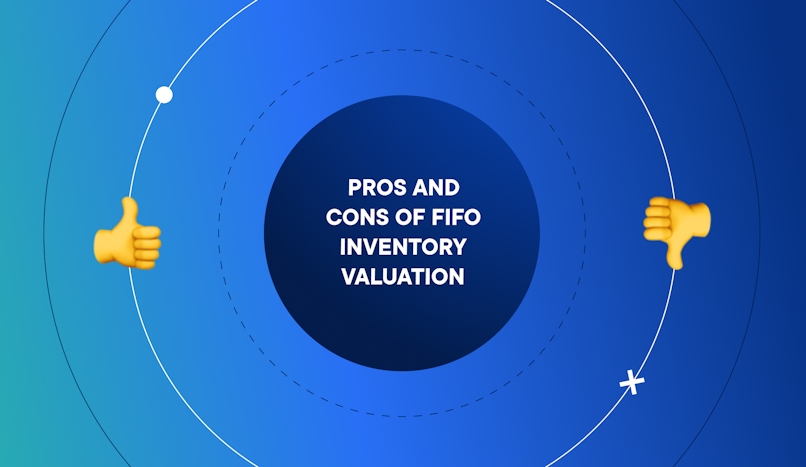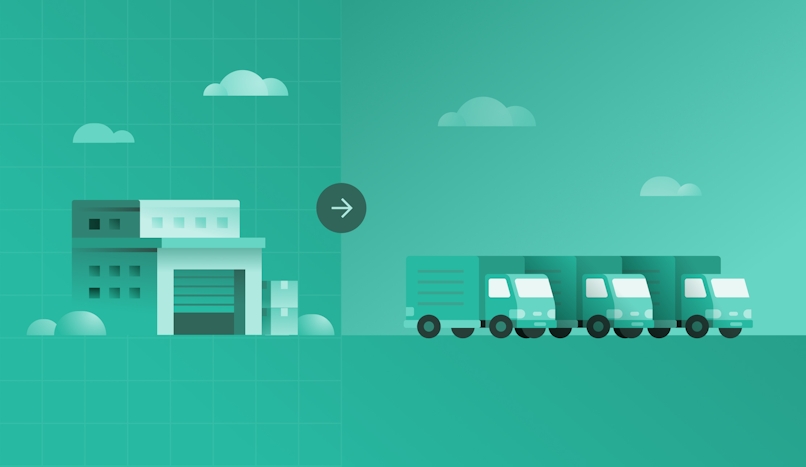A Simple Guide to the FIFO Inventory Valuation Method
Learn about the first in, first out (FIFO) inventory valuation method. We also compare FIFO vs. LIFO and explore inventory management in depth.

Once you’ve sorted your inventory valuation method, it’s time to deliver your goods to customers. Circuit for Teams can help you reduce costs by 20 percent.
Selling the right goods at the right price is critical for running a successful business.
But how is it supposed to happen if your supplier raises the price of your top-selling product?
If you raise your price, you risk losing sales, or you can take the hit yourself.
Ouch!
How will the fluctuating cost of goods affect your bottom line?
How should you keep track of inventory value when prices are constantly changing?
That’s why proper inventory management and valuation are so important.
Valuation is the process of determining the worth of your inventory, and there are several methods you can use.
The most common method is the FIFO inventory valuation method, which stands for “first in, first out.”
Below, I’Il explain the FIFO method in detail and discuss when you might want to use this method.
I’ll also give an overview of some of the other inventory valuation methods, so you can better understand your options.

What Is FIFO (first in, first out)?
FIFO is an acronym for “first in, first out.” It’s a simple inventory valuation method and the most commonly used.
The idea behind FIFO is simple: The first items you purchase are the first you sell.
This method is easy to understand and track, making it ideal for business owners with large and complex inventories.
But FIFO does have some limitations, and it’s not always the best method for valuing inventory. It’s a method for organizing and managing inventory data, so the first item entered is the first item to leave.
Let’s imagine a simple example to help visualize what FIFO means.
Imagine you have a stack of papers on your desk.
With the FIFO method, you’d arrange your stack with the oldest papers on top and the newest papers on the bottom so you can address the oldest work first — first in, first out.
Let’s bring that idea over and discuss how FIFO works in business inventory accounting.
The FIFO inventory valuation method involves selling or removing the earliest purchased inventory first.
The FIFO cost method means that the sale and use of goods follow the same order in which you bought them.
You expense the oldest costs first, and the most recent costs remain on the balance sheet.
This means you sell the old inventory (with the cost you paid) first and keep the new stuff (and the new costs) on the balance sheet.
Let’s explore how FIFO works more in-depth.

How FIFO works for inventory valuation
You know the basics: With FIFO inventory valuation, the first goods purchased are the first goods sold.
FIFO is one of the most popular accounting principles because it matches the natural flow of goods.
But FIFO is about more than the flow of goods.
It’s an accounting method used to figure out the cost of goods sold (COGS) and price inventory.
When your business uses FIFO, you can accurately reflect the changes in the value of your inventory over time.
As you sell goods, you’re selling the oldest goods first at the original COGS.
This is reflected in your gross profit.
Gross Revenue - Cost of Goods = Gross Profit
The oldest goods and the oldest costs are expensed first and are available to track as a profit.
When you purchase more goods and add them to your inventory, you’ll reflect the most recent costs as inventory and use that cost as a basis for pricing.
COGS can go up or down (inflation or deflation) depending on the market — impacting your inventory value, prices, and profits.
It’s a little complicated, but don’t worry — we’ll break it down and give you concrete examples (with numbers, fun!) so you understand exactly how FIFO works.
Using FIFO inventory valuation makes it easy to calculate your COGS.
Selling the oldest costs first helps prevent inventory pricing errors and offers more accurate reporting.
How does FIFO prevent errors?
Imagine the reverse: You sell your newest inventory first and leave the old inventory for later.
(This is called LIFO — we’ll get into it later.)
When it comes time to figure out your inventory value, you have to work backward to sort through “layers” of purchase periods, amounts, and varying COGS.
This happens in my fridge all the time.
When did we buy that again? How long has it been sitting on the shelf? Is it even good anymore?
It can get confusing and lead to errors.
Let’s relate this to manufacturing. As items move into later development stages and inventory items are sold, costs associated with the production need to be recognized as expenses.
You need to keep on top of expenses and profits for tax purposes — unless you’d like a visit from the Internal Revenue Service (IRS).
Accurately tracking your profits and expenses is essential in making sure you pay the right amount of taxes and don’t owe more than you need to pay.
With prices rising due to inflation, FIFO assigns the oldest costs to the COGS. This means the oldest costs should (theoretically) be lower than the most recent inventory.
The lower expense results in higher net income.
This also results in matching older costs against current revenue, which reflects in the cost of goods sold.
Whatever remains in your inventory is accounted for at the most recently incurred costs.
So, if the price of your hottest-selling item has increased (and your old inventory at the old price has been sold because it’s first in, first out), the price on your balance sheet should reflect the most recent costs associated with that item.
And your price should reflect the marketplace value for that item.
An example of FIFO inventory valuation
Let’s use a simple example to better understand how FIFO inventory valuation works.
Imagine that you are the owner of a small business that sells shoes.
You keep your inventory in a warehouse and use FIFO to organize and manage it.
To start, you need to purchase some beginning inventory to stock your warehouse.
You purchase a variety of shoes, including sneakers, dress shoes, boots, flats, and more.
As the business owner, you’re responsible for tracking each pair of shoes’ purchase date and cost.
Imagine you’ve purchased 100 pairs of shoes for a unit cost of $10 each — then later purchased 100 more pairs of shoes for $15 each.
You sell 60 pairs of shoes.
The FIFO method assumes you sell your older inventory first.
With the FIFO method, the COGS for those 60 items is $10 a unit because that’s how much they cost when they were first purchased.
This leaves 40 of the 140 pairs of shoes remaining in your inventory at the value of $10 a unit, and the other 100 pairs at $15 a unit.
This would make the COGS $600 because:
60 pairs of shoes x $10 = $600
Let’s say you sell 140 pairs of shoes. The math would look like this:
100 pairs x $10 a unit = $1,000
40 pairs x $15 a unit = $600
Total COGS for this period = $1,600
Regardless of the price per pair of shoes, you choose to keep your selling price at $20 a pair.
We can use this data to figure out your gross profit:
Gross Revenue - Cost of Goods = Gross Profit
You sold 140 pairs at $20 each:
$2,800 - $1,600 = $1,200 gross profit
The FIFO method doesn’t need to follow the exact flow of items through the inventory system.
And your sales pattern doesn’t have to follow FIFO cash flow perfectly.
The point here is just that FIFO is an accurate, simple method for helping you determine COGS.
FIFO is allowed by both Generally Accepted Accounting Principles (GAAP) and International Financial Reporting Standards (IFRS).
What type of goods is FIFO inventory valuation best for?
If you’re an inventory manager or business owner dealing with inventory, you know one of the key decisions you’ll make is how to value your inventory.
The FIFO method is especially well-suited for a few different types of goods.
For example, if you sell perishable items like food, drinks, or produce, your business is well-suited to FIFO because it makes sense to sell your oldest items first.
That’s why items with the closest expiration date are pushed to the front of grocery store shelves.
FIFO is a clear choice if you sell items based on expiration dates, such as medication or other items intended to be used quickly. The method allows you to keep track of the oldest costs, making sure you can move a particular product before it expires.
If you have a periodic inventory system where you check inventory at the end of each period with a physical count, FIFO is also a good fit for your business because you can accurately account for the products as they are sold.
If you run an international business, you may also need to use FIFO as your inventory valuation method.
This is because it’s one of the few approved methods under the International Financial Reporting Standards (IFRS).
The opposite method, called LIFO (last in, first out), isn’t allowed due to the “potential distortions it may have on a company’s profitability and financial statements.”
In other words, it’s easier to make errors with LIFO and get inaccurate valuations of your business inventory.

Pros and cons of FIFO inventory valuation
FIFO is popular, and for good reason. Like anything, though, the method has pros and cons.
Pros:
- Easy to understand and implement in bookkeeping
- A popular method for inventory valuation that certified public accountants (CPAs) will be familiar with
- Compatible with both generally accepted accounting principles (GAAP) and International Financial Reporting Standards (IFRS)
- Financial statements are straightforward because value follows the flow of inventory, marketplace cost, and time
- Better reflects the current inventory costs and value since the unsold products are the most recent ones
- Reduces the impact of inflation, assuming the cost of new inventory is higher than the purchasing cost of old inventory
- Reduces instances of old inventory becoming obsolete because the oldest inventory is the first to go
Cons:
- Has the potential to result in higher income taxes because there’s a wider gap between revenue and costs, creating a higher taxable income
- Has the potential to overstate profits
FIFO vs. LIFO inventory valuation methods
FIFO and LIFO are the two most common inventory valuation methods.
You already know what FIFO is, so let’s talk about LIFO.
LIFO, or “last in, first out,” is the opposite of FIFO.
In this method, the last item entered is the first to leave.
Let’s take our stack of papers as an example again.
With the LIFO method, you’d put your stack in order from the most recent to the oldest — working from the top of the pile — so you’re always working on the most recent paper.
Imagine our shoe store business again.
Shoes don’t have a shelf life or expiration date, so you don’t need to sell the oldest pairs first.
This means you could use the LIFO method instead.
Let’s use our shoe business example to compare the FIFO and LIFO methods.
FIFO method valuation
Remember, you bought the first 100 pairs at $10 and the second batch of 100 pairs at $15.
You do a physical inventory and determine you’ve sold 160 pairs of shoes in this period.
Remember, regardless of the price per pair of shoes, you choose to keep your selling price at $20 a pair.
Your gross revenue is easy to calculate:
$20 x 160 pairs = $3,200
Your cost of goods sold was:
$10 x 100 = $1,000
$15 x 60 = $900
= $1,900
Using the FIFO method to assume you sold your oldest pairs first, you can determine your gross profit:
Gross Revenue - Cost of Goods = Gross Profit
$3,200 - $1,900 = $1,300 gross profit
Your profit is $1,300.
LIFO method valuation
Now, let’s work out the same scenario using the LIFO inventory valuation method.
Your gross revenue is still $3,200, but how has your profit changed?
Your total cost of goods has changed because you sold the most recent inventory first.
Your cost of goods was:
$15 x 100 = $1,500
$10 x 60 = $600
= $2,100
Gross Revenue - Cost of Goods = Gross Profit
$3,200 - $2,100 = $1,100 gross profit
Your profit is $1,100 compared to $1,300 with the FIFO method. The FIFO method shows a higher profit.

How to determine the best inventory valuation method for your business
The best inventory valuation method for your business will depend on a variety of factors, such as:
- Your tax situation
- Any bookkeeping needs
- Inflation or deflation
- The type of goods sold
- Inventory flow or the order in which you move your inventory
LIFO is best for inflationary economies.
Inflation is when there’s a decrease in the purchasing power of money and a general increase in the prices of goods.
LIFO reflects the most recent marketplace COGS, which would be inflated (higher) — raising COGS, decreasing net income costs, and lower ending balances in inventory compared to FIFO.
LIFO inventory valuation is allowed by the IRS.
However, keep in mind that using LIFO isn’t allowed under the IFRS.
Depending on the type of business, FIFO might be your only option.
Many businesses sell the oldest items first and their ending inventory is the most recent items.
Some stock can lose value with time, so older items are prioritized for sale. FIFO is a logical fit for businesses like these.
Other businesses may not have a strict inventory flow and can sell items in any order.
LIFO might be the best option for these businesses, as it can result in lower income taxes and better reflect the actual value of their products.
Some businesses, like lumber yards, may actually sell the newest inventory first.
For these businesses, LIFO makes sense.
Inflation and deflation greatly impact businesses, and your inventory valuation method is no exception.
If you’re in an inflationary economy and costs (and profits!) are rising, your older inventory costs less than your newer inventory.
If you raise your prices before selling the older inventory, you increase your gross profit margin.
But you also increase your taxable income.
Financial reporting rules to consider
You’re a business owner.
You want to lessen your tax burden because taxes can be a significant expense for your business.
But you have to play by the rules.
The IRS has rules in place to prevent businesses from switching their inventory valuation back and forth to whatever suits the business best.
You can’t just use FIFO one year and switch to LIFO the next.
If you want to use the LIFO method, you have to file an IRS Form 970.
After you do this, you can’t switch back to FIFO or any other inventory valuation method without filling out a form and getting permission from the IRS.
If you choose to use the LIFO method for your financial recordkeeping, you’ll need an inventory system that allows you to track your inventory by older “layers” of inventory and apply the cost of that older inventory accurately.
As we discussed earlier, LIFO isn’t an option at all if you’re doing business internationally.
FIFO Inventory Valuation Method conclusion
You’ve done it.
You used this guide to determine the right inventory valuation method for your business (or simply to better understand the system you already have in place)!
But now you need to get your products from your warehouse to your customers quickly and efficiently.
You need Circuit for Teams.
With Circuit for Teams, you can reduce your delivery costs by 20 percent with optimized delivery routes for multiple drivers.
Minimize failed deliveries and deliver more per driver with the Circuit for Teams delivery management platform.
Easily create and distribute routes for multiple drivers, collect proof of delivery, and send automatic customer notifications so your customers have the most up-to-date delivery windows.
Circuit for Teams can even help you save time on payroll. Check out how Burd Eggs saves 30+ hours a week.





